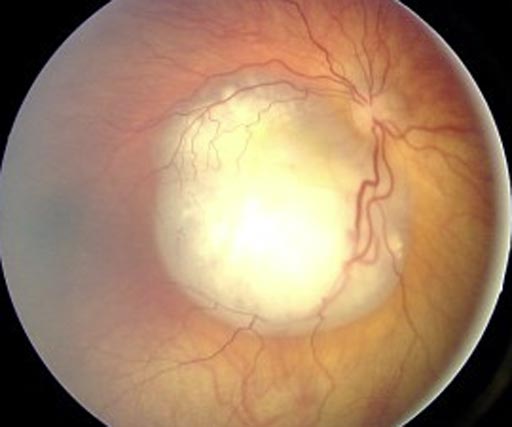Liquid Biopsy for Retinoblastoma Discovered
By LabMedica International staff writers
Posted on 24 Oct 2017
A new study indicates a proof-of-concept for a safe and effective way to derive genetic profile information from a retinoblastoma tumor without removing the eye.Posted on 24 Oct 2017
Retinoblastoma is a tumor of the retina that generally affects children under 5 years of age. If not diagnosed early, it may result in loss of one or both eyes and can be fatal. Unlike most cancers, retinoblastomas cannot be safely biopsied directly, they are only directly accessed if the affected eye is removed (enucleation) in the course of treatment.

Image: An ocular fundus aspect of retinoblastoma (Photo courtesy of Wikimedia).
The study was carried out by a team of investigators at Children's Hospital Los Angeles (Los Angeles, CA, USA) and University of Southern California (USC) Roski Eye Institute.
Retinoblastoma was one of the first tumors to have its genetic origin identified; the RB1 retinoblastoma tumor suppressor gene mutation was discovered by A. Linn Murphree, MD, a co-author on this paper. However, ocular oncologists have been limited in their ability to use this genetic information to inform diagnosis and in the application of personalized treatments, since removing tissue from the tumor in the back of the eye could spread tumor cells outside of the eye or even to the rest of the body, resulting in a far worse prognosis for the patient.
There are limits to the amount of drug that reaches the eye during chemotherapy. As a result, relapse can occur due to small tumor particles that break off and seed from the main tumor. Treatment for these seeds changed dramatically in 2012 when intraocular injections of chemotherapy were shown to be safe and effective. However it is first necessary to remove a small amount of fluid, called aqueous humor, from the front of the eye to decrease pressure within the eye prior to injection.
Previously, this fluid was simply dispensed after the procedure. “Just as I was discarding the aqueous humor, I wondered if there was a possibility it contained tumor-derived genetic material we could use to better treat our patients,” said first-author Jesse Berry, MD, of CHLA and assistant professor at USC, “We found measurable amounts of tumor DNA – genetic information from the tumor that had previously been completely unavailable from an intact eye.”
“Chromosomal changes from DNA found in the aqueous humor corroborates the chromosomal changes found in the retinoblastoma tumor,” said James Hicks, PhD, professor at USC.
The study reported on six samples from three eyes affected with retinoblastoma, in children less than three years of age. Two of the eyes had been removed primarily for treatment of the disease; the third eye was receiving intraocular injections as therapy but ultimately had to be removed due to disease recurrence. Aqueous humor was taken from all three eyes and allowed investigators to compare tumor DNA in the aqueous humor to DNA found in the retinoblastoma tumor.
“Until now, we could only do genetic analysis – and base therapy on the specific pathologic tumor features – when there was no longer a possibility of saving the eye,” said Thomas C. Lee, MD, of CHLA and assistant professor at USC. The team of investigators plans future studies to compare tumor DNA from eyes that have been saved to those that need to be removed due to tumor recurrence.
“This research has the potential to completely transform how we treat children with retinoblastoma,” said Jonathan W. Kim, MD, of CHLA and USC.
The study, by Berry J et al, was published October 12, 2017, in the journal JAMA Ophthalmology.
Related Links:
Children's Hospital Los Angeles
USC Roski Eye Institute














